英文 介绍日本文化
英文版日本人文介绍
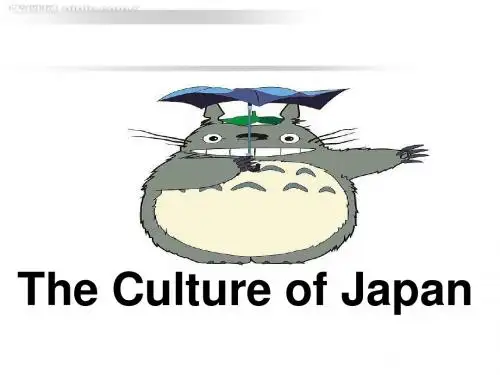
Eating a Meal Before eating, Japanese people say "itadakimasu," a polite phrase meaning "I receive this food." This expresses thanks to whoever worked to prepare the food in the meal. After eating, people once again express their thanks for the meal by saying "gochiso sama deshita," which literally means "it was quite a feast."
The word Geisha is derived from “Gei”, which in Japanese performance or entertainer, and “sha”, which means “person”, and dates back 400 years ago to the Edo period(江户 时代). During this period the Geisha entertained at banquets and social gatherings by playing Shamise(日本三弦琴), singing, and giving dance performances.
3Buckwheat ['bʌkwi:t] noodles荞麦 面条
• Buckwheat noodles or soba is also a typical Japanese dish. There are some people that eat soba at least once a day. Many office workers make it a habit to have soba for lunch. Soba noodles are a mixture of buckwheat, flour ['flauə] 面粉and eggs. It looks similar to spaghetti in shape. It is first boiled, and then dipped in a soup made of soy sauce, salt, sweet sake, and bonito[bə'ni:təu] shavings when it is being eaten. Because soba is long, it is considered a symbol of long life.
日本文化传统英文介绍
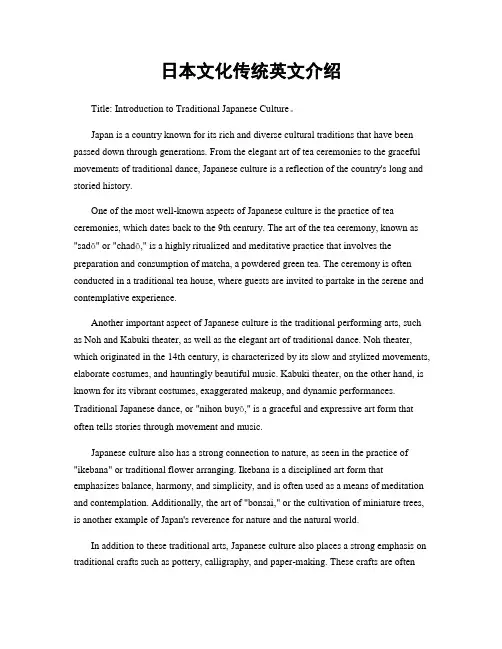
日本文化传统英文介绍Title: Introduction to Traditional Japanese Culture。
Japan is a country known for its rich and diverse cultural traditions that have been passed down through generations. From the elegant art of tea ceremonies to the graceful movements of traditional dance, Japanese culture is a reflection of the country's long and storied history.One of the most well-known aspects of Japanese culture is the practice of tea ceremonies, which dates back to the 9th century. The art of the tea ceremony, known as "sadō" or "chadō," is a highly ritualized and meditative practice that involves the preparation and consumption of matcha, a powdered green tea. The ceremony is often conducted in a traditional tea house, where guests are invited to partake in the serene and contemplative experience.Another important aspect of Japanese culture is the traditional performing arts, such as Noh and Kabuki theater, as well as the elegant art of traditional dance. Noh theater, which originated in the 14th century, is characterized by its slow and stylized movements, elaborate costumes, and hauntingly beautiful music. Kabuki theater, on the other hand, is known for its vibrant costumes, exaggerated makeup, and dynamic performances. Traditional Japanese dance, or "nihon buyō," is a graceful and expressive art form that often tells stories through movement and music.Japanese culture also has a strong connection to nature, as seen in the practice of "ikebana" or traditional flower arranging. Ikebana is a disciplined art form that emphasizes balance, harmony, and simplicity, and is often used as a means of meditation and contemplation. Additionally, the art of "bonsai," or the cultivation of miniature trees, is another example of Japan's reverence for nature and the natural world.In addition to these traditional arts, Japanese culture also places a strong emphasis on traditional crafts such as pottery, calligraphy, and paper-making. These crafts are oftenpassed down through families and communities, and are valued for their beauty, precision, and connection to the past.Overall, traditional Japanese culture is a reflection of the country's deep respect for history, nature, and the arts. From the serene beauty of tea ceremonies to the vibrant performances of traditional theater, Japan's cultural traditions continue to inspire and captivate people around the world.。
日本传统文化英文作文
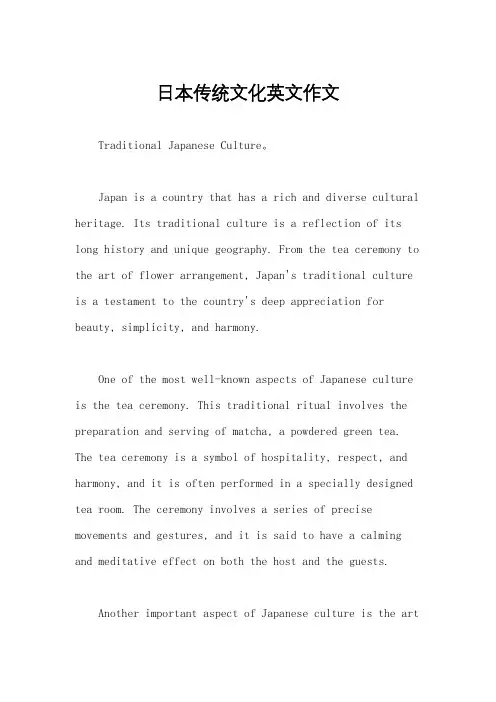
日本传统文化英文作文Traditional Japanese Culture。
Japan is a country that has a rich and diverse cultural heritage. Its traditional culture is a reflection of its long history and unique geography. From the tea ceremony to the art of flower arrangement, Japan's traditional culture is a testament to the country's deep appreciation for beauty, simplicity, and harmony.One of the most well-known aspects of Japanese culture is the tea ceremony. This traditional ritual involves the preparation and serving of matcha, a powdered green tea. The tea ceremony is a symbol of hospitality, respect, and harmony, and it is often performed in a specially designed tea room. The ceremony involves a series of precise movements and gestures, and it is said to have a calming and meditative effect on both the host and the guests.Another important aspect of Japanese culture is the artof flower arrangement, or ikebana. Ikebana is a form of art that emphasizes the beauty of simplicity. It involves the arrangement of flowers, leaves, and other natural materials in a way that creates a harmonious and balanced composition. Ikebana is often used in traditional Japanese homes and temples as a way to create a peaceful and serene atmosphere.In addition to the tea ceremony and ikebana, Japan's traditional culture also includes a variety of other art forms, such as calligraphy, painting, and pottery. Calligraphy, or shodo, is the art of writing Japanese characters with a brush and ink. It is considered a form of meditation and is often used as a way to express one's emotions and thoughts. Painting, or sumi-e, is a form ofink wash painting that emphasizes the beauty of simplicity and the natural world. Pottery, or yakimono, is a form of ceramic art that has a long history in Japan and is knownfor its delicate beauty and functionality.Overall, Japan's traditional culture is a reflection of its deep appreciation for beauty, simplicity, and harmony. From the tea ceremony to the art of flower arrangement,these traditional practices have been passed down from generation to generation and continue to be an important part of Japanese life today.。
日式文化介绍英文作文模板
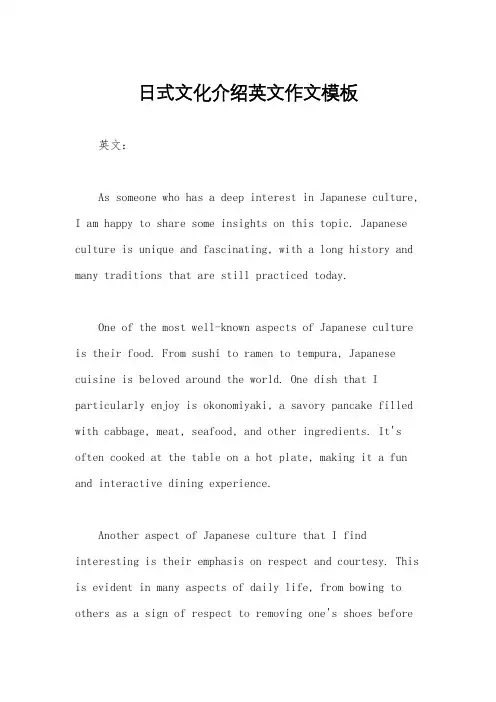
日式文化介绍英文作文模板英文:As someone who has a deep interest in Japanese culture, I am happy to share some insights on this topic. Japanese culture is unique and fascinating, with a long history and many traditions that are still practiced today.One of the most well-known aspects of Japanese culture is their food. From sushi to ramen to tempura, Japanese cuisine is beloved around the world. One dish that I particularly enjoy is okonomiyaki, a savory pancake filled with cabbage, meat, seafood, and other ingredients. It's often cooked at the table on a hot plate, making it a fun and interactive dining experience.Another aspect of Japanese culture that I find interesting is their emphasis on respect and courtesy. This is evident in many aspects of daily life, from bowing to others as a sign of respect to removing one's shoes beforeentering a home. Even the way that business cards are exchanged is done with great care and respect.In terms of entertainment, Japanese culture has also made an impact around the world. Anime and manga, for example, have gained a huge following outside of Japan. One of my favorite anime series is "Your Lie in April," which tells the story of a young pianist who rediscovers his love for music with the help of a talented violinist.Overall, Japanese culture is rich and diverse, with many fascinating aspects to explore. Whether it's through food, traditions, or entertainment, there's something for everyone to appreciate.中文:作为一个对日本文化深感兴趣的人,我很高兴能够分享一些关于这个话题的见解。
日本传统介绍英文作文
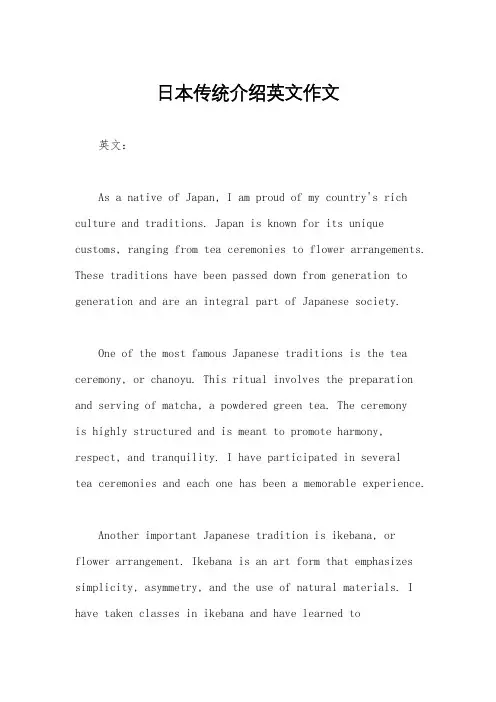
日本传统介绍英文作文英文:As a native of Japan, I am proud of my country's rich culture and traditions. Japan is known for its unique customs, ranging from tea ceremonies to flower arrangements. These traditions have been passed down from generation to generation and are an integral part of Japanese society.One of the most famous Japanese traditions is the tea ceremony, or chanoyu. This ritual involves the preparation and serving of matcha, a powdered green tea. The ceremonyis highly structured and is meant to promote harmony, respect, and tranquility. I have participated in severaltea ceremonies and each one has been a memorable experience.Another important Japanese tradition is ikebana, or flower arrangement. Ikebana is an art form that emphasizes simplicity, asymmetry, and the use of natural materials. I have taken classes in ikebana and have learned toappreciate the beauty of arranging flowers in a way that highlights their natural form.In addition to these well-known traditions, there are many other aspects of Japanese culture that are worth exploring. For example, Japanese cuisine is renowned forits freshness and attention to detail. From sushi to ramen, there is something for everyone to enjoy.Overall, I believe that Japan's traditions are an important part of our cultural heritage and should be celebrated and preserved for future generations.中文:作为日本人,我为我的国家丰富的文化和传统感到自豪。
最新日本文化的介绍(英语)

ethnic group
The Japanese nation basically consists of the Yamato, the Ryukyu, and the Ainu.
Yamato constitutes the main body of the Japanese nation, accounting for about 99.9% of the current total population of Japan
Agricultural productie development of commodity economy promotes market prosperity
It is a turbulent social transition period, and the divided country became a unity.
In 1868-1890
In 1914-1918 In 1939-1945
After the war
Economy
TOYOTA HONDA
Economy
Economy
Agriculture
Only 12% of Japan‘s land can grow food. Japanese agriculture is a highly protected industry , and because of the lack of land and labor, they use high-tech farming. Unit land production is the world's largest.
1. Located on the east coast of the Asian continent.
日本的文化英语作文
日本的文化英语作文Japanese culture is a fascinating mosaic of ancient traditions and modern innovations. It is a reflection of the Japanese people's deep respect for their heritage and their embrace of new ideas. From its rich artistic heritage to its unique social customs, Japanese culture is deeply rooted in the values of harmony, respect, and perseverance.One of the most striking aspects of Japanese culture is its traditional arts. These include practices such as calligraphy, painting, pottery, and origami. Calligraphy, known as shodo in Japan, is not only a form of artistic expression but also a means of practicing discipline and focus. Japanese painting, with its delicate brushstrokes and use of natural motifs, showcases the country's appreciation for the beauty of nature. Pottery, particularly the kiln techniques used in regions like Arita and Seto, has a long history and is cherished for its beauty and functionality. Origami, the art of folding paper, is both a traditional pastime and a significant part of Japanese cultural events.Japanese cuisine, known as washoku, is world-renowned for its delicate flavors, intricate presentation, and emphasis on seasonal ingredients. Dishes such as sushi, tempura, and ramen have gained global popularity, reflecting the influence of Japanese cuisine on world food cultures. The art of tea ceremony, orchanoyu, is another important aspect of Japanese culture, symbolizing harmony, respect, and tranquility.Social customs in Japan are characterized by a strong sense of etiquette and respect. The concept of omotenashi, or hospitality, is deeply ingrained in Japanese society. This is evident in the attention to detail in service industries, the importance of gift-giving, and the practice of bowing as a form of greeting. The Japanese people's respect for elders and their commitment to maintaining harmony in social interactions are also notable aspects of Japanese culture.In recent years, Japanese culture has also influenced global trends in fashion, animation, and technology. Japanese street fashion, with its bold andinnovative styles, has captured the imagination of fashion enthusiasts worldwide. Anime and manga, Japanese forms of graphic storytelling, have become global phenomena, introducing Japanese cultural elements to audiences far and wide.In conclusion, Japanese culture is a unique blend of tradition and modernity. Its rich heritage and innovative practices continue to inspire and captivate people around the world. The Japanese people's dedication to preserving their cultural traditions while embracing new ideas is a testament to the dynamic and fascinating nature of Japanese culture.中文翻译:日本文化是一幅由古老传统和现代创新构成的迷人马赛克。
日本生活文化介绍英文作文
日本生活文化介绍英文作文英文:Living in Japan is a unique and enriching experience. The culture is rich with traditions and customs that have been passed down for centuries. One of the most fascinating aspects of Japanese life is the attention to detail and the emphasis on hospitality. Whether it's enjoying atraditional tea ceremony or staying in a ryokan, the Japanese take pride in providing a high level of service and ensuring that guests feel welcome and comfortable.Another interesting aspect of Japanese culture is the focus on harmony and respect. This can be seen in the way people interact with each other, as well as in the design of public spaces and the natural environment. For example, the concept of "wa" or harmony is deeply ingrained in Japanese society, and it is reflected in the way people strive to maintain peaceful relationships and avoid conflict.In addition, the food culture in Japan is truly exceptional. From fresh sushi and sashimi to hearty bowls of ramen, Japanese cuisine is diverse and delicious. I have had the pleasure of trying many different types of Japanese dishes, and each one has left a lasting impression on me. The attention to presentation and the use of seasonal ingredients make dining in Japan a memorable experience.Living in Japan has also given me the opportunity to participate in various cultural activities, such as wearing a kimono, learning the art of origami, and attending traditional festivals. These experiences have allowed me to gain a deeper understanding and appreciation for Japanese culture.Overall, life in Japan is a wonderful blend oftradition and modernity, and I feel fortunate to have the chance to immerse myself in such a unique and captivating culture.中文:生活在日本是一种独特而丰富的体验。
日式文化介绍英文作文
日式文化介绍英文作文下载温馨提示:该文档是我店铺精心编制而成,希望大家下载以后,能够帮助大家解决实际的问题。
文档下载后可定制随意修改,请根据实际需要进行相应的调整和使用,谢谢!并且,本店铺为大家提供各种各样类型的实用资料,如教育随笔、日记赏析、句子摘抄、古诗大全、经典美文、话题作文、工作总结、词语解析、文案摘录、其他资料等等,如想了解不同资料格式和写法,敬请关注!Download tips: This document is carefully compiled by theeditor. I hope that after you download them,they can help yousolve practical problems. The document can be customized andmodified after downloading,please adjust and use it according toactual needs, thank you!In addition, our shop provides you with various types ofpractical materials,such as educational essays, diaryappreciation,sentence excerpts,ancient poems,classic articles,topic composition,work summary,word parsing,copyexcerpts,other materials and so on,want to know different data formats andwriting methods,please pay attention!Japanese culture is really interesting. They have unique food like sushi and ramen that are loved by people all over the world.The anime and manga in Japanese culture are super popular. You can see characters with all kinds of amazing powers and stories.The traditional Japanese gardens are so beautiful and peaceful. It's like stepping into another world.Their festivals are full of colors and excitement. People dress up in traditional clothes and have a great time.The respect for elders and traditions is very strong in Japanese society. It shows in their daily lives.。
关于日本文化的小作文英语
关于日本文化的小作文英语Japanese culture is a fascinating blend of ancient traditions and modern innovations. It is a society that values harmony, respect, and aesthetic beauty, which is evident in various aspects of its customs and daily life.One of the most striking features of Japanese culture is its art. Traditional arts such as calligraphy, pottery, and tea ceremony are still practiced and revered today. The tea ceremony, in particular, is a choreographed event that involves the ceremonial preparation and presentation of matcha, a powdered green tea. It is a spiritual experience that emphasizes the beauty of simplicity and the importance of hospitality.Another significant aspect is the Japanese architecture, which ranges from the minimalist and serene Zen gardens to the towering skyscrapers of Tokyo. Traditional Japanese homes often include tatami mats, shoji screens, and a tokonoma, which is a designated space for displaying art and flowers.The Japanese cuisine is also a reflection of the country's cultural values. It is known for its emphasis on seasonality, presentation, and the use of fresh, high-quality ingredients. Sushi, sashimi, and ramen are just a few examples of the diverse and delicious dishes that have gained popularity worldwide.In terms of social norms, the Japanese place a high value on politeness and social hierarchy. Bowing is a common way to greet, show respect, or apologize. The language itself has different levels of politeness and formality, which arechosen based on the speaker's relationship to the listener.Contemporary Japan is also known for its technological advancements and pop culture. From anime and manga to video games and robotics, Japan has a significant influence onglobal entertainment and innovation.In conclusion, Japanese culture is a rich tapestry of history, tradition, and modernity. It is a culture that continues to evolve while maintaining a deep respect for its roots.Whether you are interested in its traditional arts, culinary delights, or technological achievements, Japan offers aunique and enriching cultural experience.。
- 1、下载文档前请自行甄别文档内容的完整性,平台不提供额外的编辑、内容补充、找答案等附加服务。
- 2、"仅部分预览"的文档,不可在线预览部分如存在完整性等问题,可反馈申请退款(可完整预览的文档不适用该条件!)。
- 3、如文档侵犯您的权益,请联系客服反馈,我们会尽快为您处理(人工客服工作时间:9:00-18:30)。
The cherry blossom is the flower of flowers to Japanese people. It symbolizes their national character. This is because the life of a samurai (日 本武士)of feudal times was proverbially (众所周知)compared to the short-lived cherry blossoms that last” no more than three days ”, for a samurai was always ready to sacrifice his life for the sake of his master. Another meaning is “what the cherry is among flowers is the samurai among men ”.
Mt. Fuji has different views, changing with the seasons and even as the time flows during a day. Views from different viewpoints give different impressions. In winter, it is covered with pure white snow. In summer, its bluish torso(躯干) wears a delicate crown of snow and stands in the mist. This Mt. Fuji is beautiful and magic, isn’t it?
There is often a misconception (误解) by some that Geisha are prostitutes(娼妓), but nothing could be further from the truth Geisha are refined and cultured girls and woman who are highly trained in a variety of traditional skills. Besides playing Shamisen (日本三弦琴), singing, and dancing, the Geisha perform the Japanese tea ceremony, and are well versed(精通的) in the art of conversation. Many learn to speak English to entertain Western guests.
The Japanese are very proud of their Sakura. Of all flowers, the cherry blossoms appeal most to the aesthetic taste of(审美品位) the Japanese people.
The Japanese people are never so jubilant(欢欣雀跃), cheerful, optimistic and youthful as they are at the time of ”Sakura” blossom.
In Japanese, the cherry is called ”Sakura”, which is generally believed to be a corruption of the word “ Sakura” (blooming ) from the name of Princess KonoHana-Sakura-Hime.
The highest peak in Japan(3,776meters), Mt. Fuji, is a relatively young volcano. The mountain is said to have occurred in 1707. For almost 300 years since then, Mt. Fuji has been quiet and retained its rarely noble figure, but some experts say that it will surely awake again.
The word Geisha is derived from “Gei”, which in Japanese performance or entertainer, and “sha”, which means “person”, and dates back 400 years ago to the Edo period(江户时代). During this period the Geisha entertained at banquets and social gatherings by playing Shamise(日本三弦琴), singing, and giving dance performances.
In mountainous Japan, most of the mountains are part of mountain ranges. Mt. Fuji, however, soars into the sky alone. Located almost in the center of the country, this well-proportioned coneshaped mountain has been worshiped by the Japanese people since ancient times, and is a well-known symbol of Japan in other countries.
With a left paw raised he welcomes guests and customers. With a right paw raised he welcomes wealth or luck. Traditions differ on whether the cat is a male or female, but Maneki Neko is always depicted as a friendly figure. The scroll he carries bears the congenial(和蔼的) message. “Please come in. You are welcomes!”
The Maneki Neko is a figure of Japanese traditional that welcomes guests, customers, luck, and wealth. “Maneki Neko” means “beckoning(召 唤) cat” in the Japanese language. His image usually faces the door near the main entrance.
The training involved in becoming a Geisha is very rigorous(严格的), and because of this the numbers of Geisha are declining.
Today in Japanese hotels and restaurants Geisha still entertain at banquets and socialize with guests, and the role of the Geisha in Japanese society is always a source of curiosity for tourists.
This long name means “tree-flowers-booming princess”, for the cherry was so well-known in those early days in Japan that the flower meant nothing but cherry. The princess was so named because, it is said, she fell from heaven upon a cherry tree.
法学0904班 张鹤玲 王颖
With economic, cultural and religious influence from neighboring Asian states, Japan has produced a unique culture of its own. Now let’s enjoy the charm(魅 力) of Japanese culture and look at some of its popular icons.
There are many stories about Maneki Neko. One of the most popular is that the cat in a temple once saved a lord(领主) with raising a pbelieve where there is Maneki Neko, there is wealth, luck, and welcomes.
